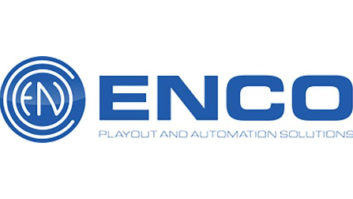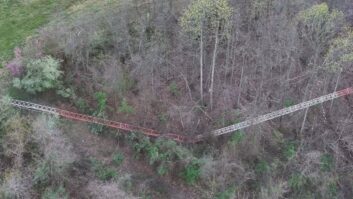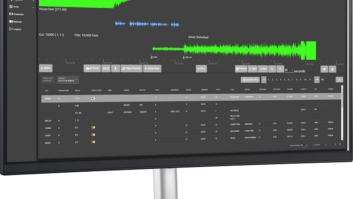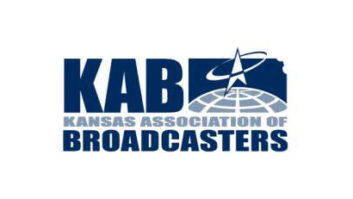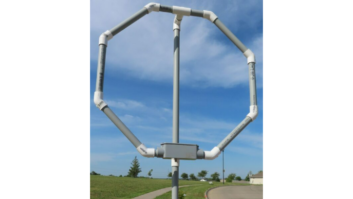Q. What kind of products or services does your company offer for professional audio buyers/users – especially those who might be attending the NAB show?
A. SoundField manufactures a range of broadcast microphone systems that will operate on main power or rechargeable battery power and simultaneously generate mono, stereo and 5.1 surround. Each system consists of a microphone equipped with four capsules and a control unit, which can be situated up to 300 m from the microphone head, but from which all parameters, such as polar patterns and mic orientation, can be adjusted and monitored.
The products offer a cost-effective, convenient means of generating phase coherent surround audio for HD that can be folded down to stereo for SD or mono for radio without frequency imbalance or loss of essential audio information.
These facilities, which are unique, resulted in the products being specified to provide the 5.1 surround for the Soccer World Cup in Germany, which was transmitted to an estimated world audience of 40 billion people. In the U.K., the Rupert Murdoch-owned satellite broadcaster SKY has now standardized on SoundField for it’s HD coverage of Premier League Football and in addition has permanently installed SoundField systems in many of the major U.K. football stadiums. Their usage of our products is now being extended to both rugby and cricket coverage.
Q. What’s new that you will show at NAB2007?
A. We’re very proud to be showing our first digital microphone system – the DSF-2. It’s been five years in R&D and has been specifically designed for coverage of large-scale OB sporting events.
Also on show will be our recently introduced ST350 Portable System and the new SPS-200 A-Format microphone, which delivers the same audio formats as our more expensive models in the range, but is completely software driven and runs on standard 48 V phantom power from any mic-pre or mixing console.
Q. How is your new product offering different from what’s available on the market?
A. What is different about SoundField technology as opposed to the other products out there is that we are offering broadcasters a proven, single microphone alternative to multiple spaced mic arrays or multiple spaced capsule ‘dummy heads’ – and the means to avoid the phasing problems that these entail when collapsed to stereo and mono.
In addition our new DSF-2 digital microphone system allows the OB truck to be situated 1.3 km from the microphone head if required – without loss of signal level or quality. If you run standard microphones down those kinds of cable lengths the audio that arrives at the mixing console is of little use.
Another major factor that differentiates our products is that they will all output our proprietary SoundField B-Format. This is four channels of audio which together contain the left/right width information, the front/back depth information and the up/down height information – in essence a three-dimensional snapshot of any acoustic event. If these four channels are recorded they can be utilized in post production at a later date with our Surround Zone software plug-ins to produce 5.1 mixes or any future surround format. Surround Zone runs on Digidesign Pro Tools, Nuendo and SADIE with new platforms being added in the near future.
Q. What is the biggest issue concerning your industry?
A. It’s perhaps not the biggest issue, but I find it unfair that small, specialist, pro-audio manufacturers are subjected to the same blanket legislation of ever increasing European directives and regulations as the manufacturers of household white goods or computer systems.
In principle, the RoHS directive, which makes it illegal to sell products containing lead, cadmium or other hazardous substances is a good thing, particularly when you consider the scale of obsolete consumer items being dumped in the earth. Although, I’m not sure the European [Union members] comprehend the amount of redesign, component substitution and associated costs of all this to achieve compliance within the required time frame. Similarly, the WEEE directive, which will now result in an annual fee being paid by every manufacturer to fund the cost of the disposal of obsolete items, is highly applicable to television, refrigerator and computer manufacturers – but is it really relevant to companies like ourselves whose products retain their value over a 30-year lifespan and are manufactured in such tiny quantities? The cost of all this has to be factored into the products.
Many of today’s successful U.K. pro-audio manufacturers started in the 1960s and ’70s with a man who was passionate about circuits and sound – this was certainly the case for companies such as Soundcraft, Klark Teknik and Drawmer. Today’s young designers and potential company founders who are just starting out will have to contend with the daunting prospect of RoHS, WEEE, EMC, CE, annual factory inspections, and submitting product samples to a whole raft of overseas markets for laboratory testing to obtain local safety standards.
My concern is that these young talents will inevitably have to take their unique designs and product ideas, ‘cap in hand’, to the large established manufacturers, which will result over time in the stifling of innovation and a severe reduction in the number of small independent minded companies which exist now.
Q. Where are you based and how many employees do you have? Anything else we should know about your company?
A. Wakefield, West Yorkshire, U.K. – we are a small specialist company tightly focused on the production of high-end microphone systems capable of generating multi-channel audio and software surround post-production tools. We have ten employees.





